Set against the rocky coast of western Bali lies a sacred rock topped by a Hindu temple, a creation of the Majapahit priest, Nirartha, who fled Java to Bali in the 16th century. Known as the reformer of Balinese Hinduism concept of deity, among other things, Nirartha introduced Acintya – the one source of all divinities – to answer the widespread of monotheistic Islam in Java and provide Balinese with the same concept of monotheism.
Acintya, often depicted as a naked human-looking form with flames around him, is also referred as Sang Hyang Widhi Wasa – a term coined by Christian missionaries in 1930 to introduce Christian God to Balinese. Against all odds, Balinese is still a largely Hindu society in the 21st century, worshiping Sang Hyang Widhi Wasa and other gods as his manifestations.
In addition to the introduction of Acintya, Nirartha was also the figure behind the construction of sea temples around the coast of Bali to venerate the sea gods. Pura Tanah Lot, completely separated from the mainland during high tide, is the most prominent of such temples, purportedly guarded by venomous sea snakes and a mythical giant snake. A bridge was built to connect the rock with the mainland, but none was ever completed, always washed away by the rough waves of Bali Strait.
The deeply superstitious Balinese people saw it as a sign from the gods that no bridge should ever be built at Tanah Lot. As a result, to satisfy the sea gods and ask for their protection, each year the locals would sacrifice animals, including cows. They would first be taken to the base of the temple where the priests walk them around the temple, before being taken by boats to the sea, and sacrificed.
One century after the completion of Pura Tanah Lot, a temple was built at the shore of Lake Bratan to honor Dewi Danu, the goddess of water, river and lake. I Gusti Agung Putu, the founder of Mengwi Kingdom – one of the island’s most respected kingdoms in the 17th century – commissioned the construction of the temple, Pura Ulun Danu Bratan, following his success in establishing the kingdom after defeating his opponents.
“They don’t dare to build a bridge here,” Bli Komang explained the absence of bridge between the temple and the lake shore. “They are afraid the same thing that happened to Tanah Lot would also happen here.”
I looked at Lake Bratan, a calm lake with verdant hills around, lightly showered by the morning’s drizzle. The biggest waves I witnessed were merely ripples created by water falling from the sky. In this deeply superstitious society, however, any bad omen from the future and past would be taken seriously, mostly out of their desire to live in harmony with the gods. Tri Hita Karana does revolve in their lives.
Perched on an ijuk roof – dried black fibers from palm trees – a gilded figurine surrounded by ornate embellishments sat atop mythical Balinese creatures. Acintya, more than four centuries after his introduction in Balinese Hinduism, overlooked Lake Bratan, the abode of one of the divinities that emanated from him. The religion, it seems, is such an eclectic potpourri of ancient animism, Indian Hinduism, monotheistic belief and constant influx of new ideas, resilient like Balinese people themselves.
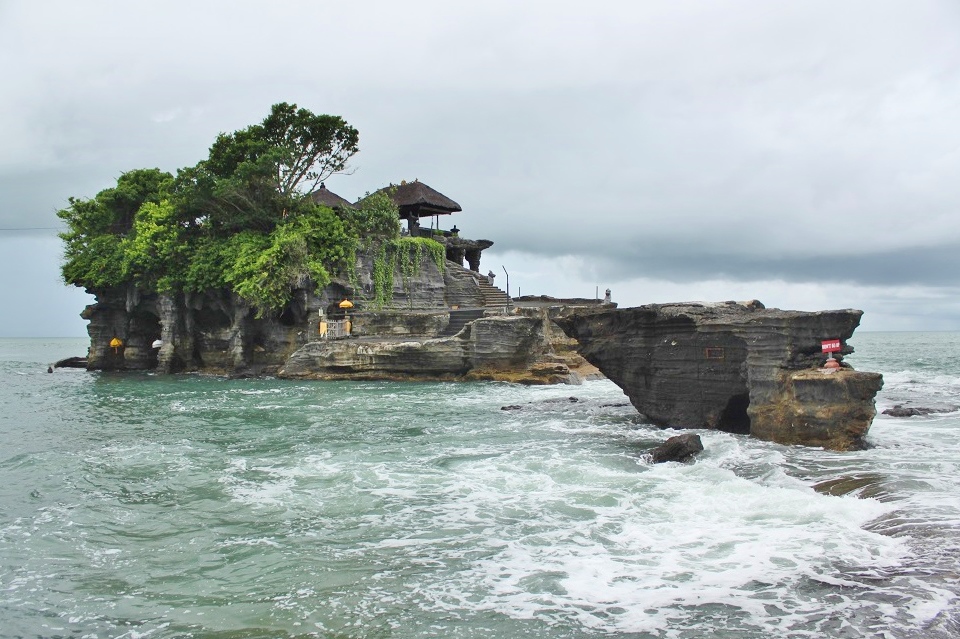
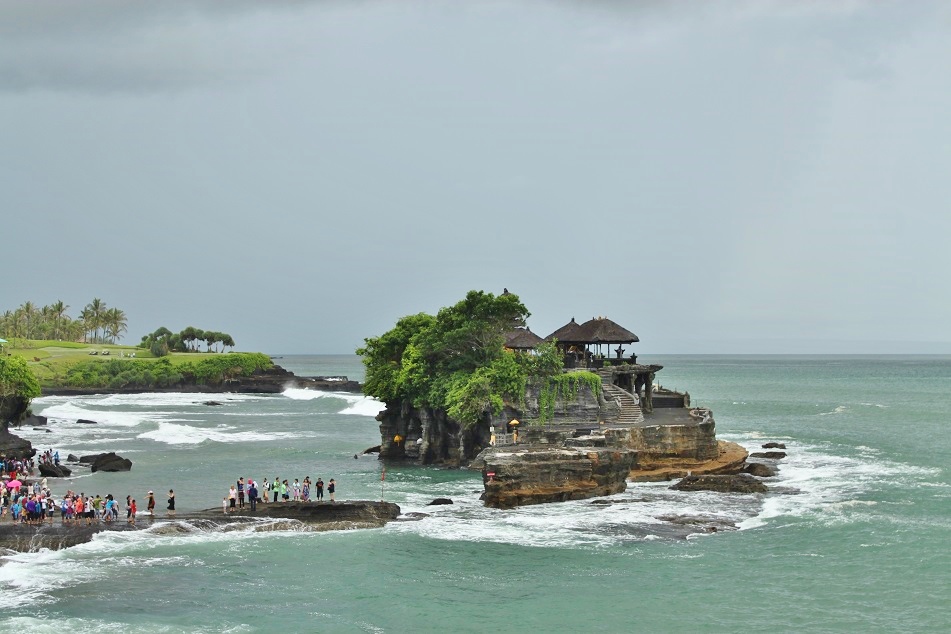


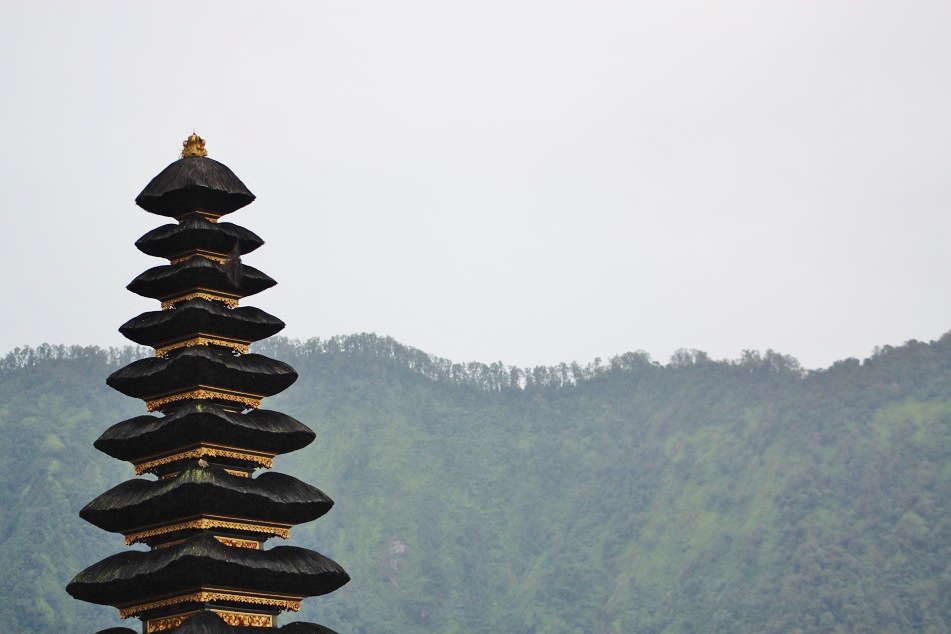

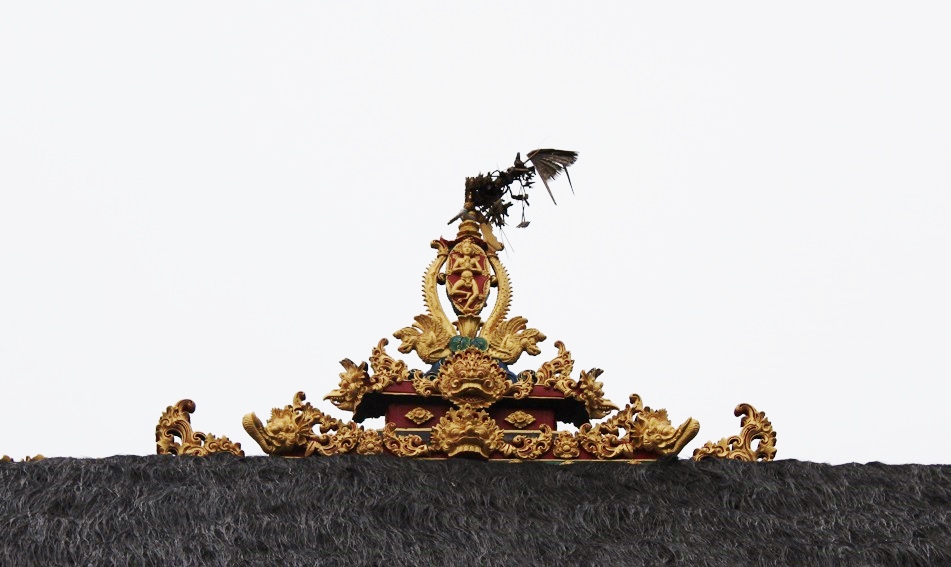



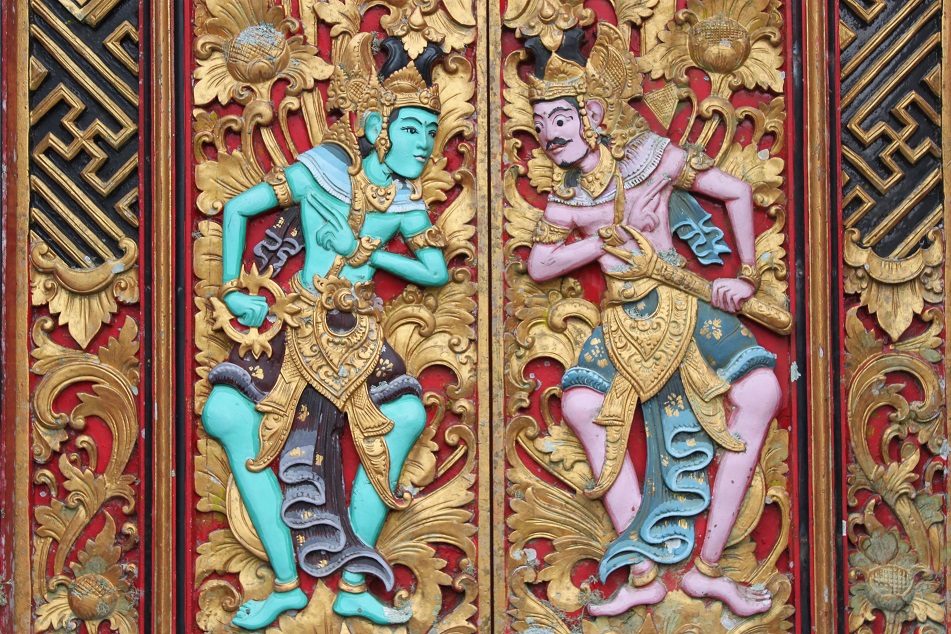

I have been there years ago and this place was spectacular. Still have it planted deep on my mind! Those multi-tiered roof is called a “Tumpeng” and the name of each of this structure is named according to it’s number of roof.. Just sharing what I heard about from a Balinese.
LikeLike
Balinese temples are truly beautiful, indeed. As far as I know ‘tumpeng’ is a general term to describe a conical object/structure in Indonesia, hence the name of Nasi Tumpeng – conical yellow or white rice accompanied with lots of side dishes often served during ceremonies/celebrations. The multi-tiered roofs of Balinese temples were made that way to symbolize Meru, a mythical sacred mountain in Hindu mythology where the gods reside. Therefore some also call the roofs meru.
LikeLike
I see…. Thanks for the info… 🙂
LikeLike
You’re very welcome.
LikeLike
Very beautiful
LikeLike
They were. But Pura Tanah Lot can be very touristy while Pura Ulun Danu Bratan is often shrouded in mist due to its location on Bali’s highlands.
LikeLike
Beautiful pictures, Bama… Paling suka suasana Pura Ulun Danu yang dikelilingi bunga-bunga di sekitar pura, rasanya damai banget lihat danaunya yang tenang 🙂
LikeLike
Thank you, Halim. Damai dan tenang memang dua hal yang mudah sekali dirasakan di Pura Ulun Danu di Bratan, kecuali ketika peak season dimana banyak orang datang ke pura ini. Paling enak datang pagi-pagi sekali. 🙂
LikeLike
Reblogged this on mgtrrz's Blog and commented:
This Is Absolutely ‘Meditation’ WORTH !!!
LikeLike
Gorgeous, Bama – beautiful shots of these wildly romantic temples. I’m so interested in how humans lavish such imagination and love on their places of worship – the amazing places we’ve created over the centuries – no, millennia – are such a legacy of devotion to our disparate beliefs. 🙂
LikeLike
Thank you, Meredith. The fact that the world’s most breathtaking, beautiful, magical and majestic buildings are mostly places of worship does tell something about humans’ penchant for creating lavish religious structures – driven by the devotion of a power greater than us, as you said.
LikeLike
Amazing ! beautiful depiction with snaps.
LikeLike
Thank you for your kind words!
LikeLike
Fabulous post Bama. The first three photos are real eye poppers for me. I feel my wanderlust acting up. 🙂
LikeLike
Thank you, Sue. The thing about Pura Tanah Lot is that it is one of Bali’s most visited places. So to beat the crowd it would probably be better to go really early in the morning.
LikeLike
Sounds like most tourist spots anywhere in the world. Thank you for the tip!
LikeLike
Reblogged this on Hadel.
LikeLike
Really great post, thanks for sharing. Bali is one of my all time favourites and I’ve been to quite a few of the temples. Amazing places. I’ve not been to Tanah Lot yet – the popularity and crowds put me off a bit – but seeing your post I am very tempted to go next time we are there.
LikeLike
Thank you for reading. Last week I went to Bali again and was quite shocked with how crowded some parts of the island could be during peak season. However on that trip I decided to explore a part of Bali I’d never been to: the north. There were some beautiful temples near Singaraja in the northern part of the island, and I met a very interesting old caretaker of a temple who explained to me and my friend so many aspects of Balinese Hinduism which we were not aware of before.
LikeLike
Yes the peak season is nuts!! The north is definitely better for avoiding the crowds, in my experience. Much more tranquil. It sounds like you had a fantastic trip.
LikeLike
Even the usually calm and soothing Ubud couldn’t handle that many tourists. It was indeed a fantastic trip, however since we went there on Saturday some of the museums we wanted to visit were closed. Maybe next time.
LikeLike
A great excuse to go back – good thinking! 😉
LikeLike
Great shots…..I’ve never seen tanah lot at high tide aja indah! Sangat suka pura ulun danu : )
LikeLike
Makasih! I’m lucky that on my two visits to Tanah Lot I experienced the temple and its surroundings in two completely different settings: low and high tide. Pura Ulun Danu was also a nice pura, set against the beautiful ancient caldera with mist constantly flying low above the lake.
LikeLike
A fascinating post, Bama! I had no idea that Sang Hyang Widhi Wasa was an introduced name, or that the concept of Acintya was brought over from Java. I loved the anecdote about the lack of a bridge to either Pura Tanah Lot or Pura Ulun Danu Bratan. 🙂
LikeLike
Makasih James! In the past Hinduism in Indonesia was very much similar to the one practiced in India, the land where the religion originated from. However over the course of centuries the rise of Islam in Java, the arrival of Christianity to Bali, and the ancient practices of animism, and modern ideas have shaped Balinese Hinduism and made it into an entirely different religion than what it originally was. It was actually Bli Komang who told me about the bridges, and you know how superstitious he can be. 🙂
LikeLike
Beautiful! So much detail on the temple, and it looks like they maintain it very well. Thanks for introducing it to us!
LikeLike
Thank you Celia and my pleasure! Since Balinese are still largely Hindus, most of the temples are quite well-preserved, even the old ones.
LikeLike
How beautiful photos!
LikeLike
Thank you for your kind words, Adrienn.
LikeLike
Stunning photos!
LikeLike
Thanks a lot for such a lovely comment!
LikeLike
GREAT photos, especially the one with the caldera as the backdrop against the multi-layered temple. I loved Tanah Lot, it was the first Balinese temple I ever visited, and may have been the least stressful 🙂 I think much like Itsukushima Shrine in Japan, it is wise to visit Tanah Lot for the day so you can experience it during both low tide and high tide.
LikeLike
Thank you, Lee. It’s great that Tanah Lot left a good impression to you. I was a bit put off by the number of vendors littering the path to the temple on my first visit, but it’s common in many touristy places in Indonesia anyway. Itsukushima Shrine is one of the most iconic places in Japan, so I guess there’s really something about a temple surrounded by water. 🙂
LikeLike
Amazing! This post has definitely added another spot to my bucket list. lol
LikeLike
Thanks Rebecca. Hopefully you’ll visit Bali soon! 🙂
LikeLike
OMG this looks so beautiful! I really wanna go to Bali so soon! Do you have a Bali itinerary or something? What is the best route? It consists of several different islands right?
LikeLike
Bali is such a photogenic island, indeed. I don’t really have an itinerary, plus I’ve been to the island for 6 times now. It really depends on what you want to see, what your interests are and how much time you have. Bali has cultural scenes, beaches, lakes, palaces, diving sites, forests, ancient sites, and many more. Bali is one island with some smaller islands nearby.
LikeLike
I see! wow 6 times? Where do you live?
LikeLike
I live in Jakarta, less than two hours away by plane from Bali. 🙂
LikeLike
Reblogged this on The Pour Out and commented:
WOW!
LikeLike
Ah, you remind me of the time when I was a kid, when my grandma told me stories of Dang Hyang Nirarta, along with those Mahabharata and Ramayana tales. Nice post Bama! and awesome pictures too!
LikeLike
Your grandma told you well, Teddy. Hopefully parents today remain telling their children those stories are they are not only incredible but also helped shape Indonesian cultures. Thanks for your kind words! 🙂
LikeLike
Simply AMAZING…
LikeLike
Thanks Elena.
LikeLike
Fascinating photos and information. I especially like the multi-tiered roofs. I have always wondered why, in so many religions, keeping the gods happy requires sacrificing either people or animals.
LikeLike
Thanks Marilyn. The multi-tiered roofs are indeed very special, some mosques in Indonesia even adapted the design instead of using Middle Eastern onion domes. On sacrificing animals, as far as I know it is one of the oldest rituals known in human history. Maybe that’s why it is still widely practiced in many parts of the world.
LikeLike
Bali is so beautiful, unfortunately we didn’t make it to Ulun Danu on our last trip. We did go to Tanah Lot, and while it was very beautiful, I was thrown off by the amount of the tourists and all of the vendors in the “market” selling trinkets and souvenirs – that place is popular! I loved reading the tales behind the temples here.
LikeLike
That means one day you have to go back to the island. 🙂 The next time you come I do recommend visiting the eastern part of Bali for its less-touristed places and beautiful water palaces, or the north of the island where you can find temples so different from what most people know about. On the popularity of Tanah Lot, the number of vendors was indeed quite shocking. I surely hope that the temple won’t lose its sacredness and charm despite the mass tourism.
LikeLike
great photos! I would love to visit Bali some day 🙂
LikeLike
Thank you, Nata. Bali is a very popular island and at times can be so crowded. Try not to go there on peak season, but even if you do, there are many parts of the island which remain very much secluded and quiet.
LikeLike
Great article Bama! Thanks for sharing the story behind Tanah Lot temple. I have been wondering myself when visiting it. Beautiful capture too, Bali is always fascinating and full surprises 🙂 Have a great weekend!
LikeLike
Thanks Indah! I was lucky to have a driver who understood the history behind this popular Balinese temple. Bali is indeed one of the most fascinating places that I’ve been to. Its rich culture adds to the appeal immensely. Have a great weekend too! 🙂
LikeLike
It is amazing how these people have adapted and reformed the Hindu religion and transformed it into something so quintessentially Balinese! I think that is why it survived against all odds as you say. A wonderful post Bama. Your photos are breathtaking. The lone little temple on the narrow promontory is my favourite shot of all.
LikeLike
Indeed, Madhu. Bali proved to be not only an island where the priests and royal families of the last major Hindu kingdom in Java sought refuge, but also where Hinduism found its stronghold in the modern-day Indonesia. Thanks Madhu. It was a little cloudy the last time I went, but I’m glad I still could capture the beauty of the temple.
LikeLike
Great photo and wonderful informations Thanks 🙂
LikeLike
My pleasure. Thanks for reading.
LikeLike
Hi Bama, I’m learning more about Balinese spirituality from your posts. It’s interesting that the Balinese have over time creatied their unique form of Hinduism. Pura Tanah Lot looks mystical and seem a perfect place to built a temple. The temple itself is fo exquisite. Great post.
LikeLike
I’m glad this post gave you some insights on Balinese Hinduism: a unique blend of Hinduism with pre-Hindu beliefs, adjusted to fit in modern Indonesia’s basic principles. Pura Tanah Lot definitely has one of the most stunning setting compared to other temples in Bali, no wonder it’s also one of the most popular and frequently visited. Thanks Marisol!
LikeLike
Reblogged this on Galoms.
LikeLike
Pingback: A Bat Cave Like No Other | What an Amazing World!
Beautiful story and beautiful photos!
LikeLike
Thank you, Maša!
LikeLike
I never had the explanation of why there isn’t a bridge at Pura Ulun Danu. That is an interesting fact. Thanks for enlightening me:)
LikeLike
Had my driver not told me, I wouldn’t have known about it either. I believe there are more to discover beyond the surfaces of Bali’s Hindu temples. Thanks for dropping by! 🙂
LikeLike
Lovely story and lovely pictures!
LikeLike
And such a lovely comment from you. Thank you!
LikeLiked by 1 person
Wonderful post. It must have taken such amazing patience for the builders of these temples to carry each element into place. What greater tribute could there be to the venerated sea gods. Thanks for sharing all of the lovely photos.
LikeLike
I don’t know how long it took to build the offshore temple, but judging from the strong nature of Bali’s western coast it might have taken years or even decades to complete. Thank you for reading and your kind words.
LikeLike
WOW!!! I’m dreaming thanx to your posts…this blog is wonderful!!! I’ll follow you!! I hope you’ll visit our blog duecuorieunaciccions.wordpress.com big huggs!!
LikeLike
Hi Pasquale and Claudia! Thanks for dropping by and leaving such a lovely comment. All the best!
LikeLike
It’s really difficult to not be enchanted by this island and your post! I am aware that I’ve not spent enough time in Bali and its a petty not having visited Pura Tanah Lot. We, have, however, visited the Taman Ayun or Besakih temple and were very touched by the beauty of the whole surroundings. Very best regards
LikeLike
That’s true, Martina. Bali’s cultural scenes and unique traditions are so enchanting that now they’re the main reasons for me to keep coming back to the island. If you happen to visit Bali again in the future, I recommend exploring the east and north parts of the island for more laid back atmosphere, relatively less-crowded places, and more Hindu temples.
LikeLike
Awesome blog. I love it. Good to see those asian culture.
LikeLike
Thank you for such an encouraging comment, Timothy. Culture is one of the main things I always look for every time I travel.
LikeLiked by 1 person
Beautiful pictures! 😀
LikeLike
Thank you, Raul.
LikeLike
What a beautiful and colorful country you live in. It must be a photographers paradise. I can’t wait to get there in a few weeks and I look forward to reading all your posts.
LikeLike
My best friend, who is from Hong Kong, now always makes excuses to go back to Indonesia. He loves the cultural scenes, the landscapes and the local dishes, although he found some of them quite spicy at first. Let me know if you need more information on the country.
LikeLike
Reblogged this on vacantedragute.
LikeLike
Reblogged this on 3 Months in Melbourne and commented:
It’s good that someone has written this
LikeLike
Love these photos!!So beautiful!!
LikeLike
Thank you. Glad you like them.
LikeLike
Great pictures and blog 🙂 I´m planning to go to Bali in March! If you want advice about other destinations check http://www.youngtravelbug.com
LikeLike
Hi Claudia. Thank you for dropping by and leaving such a kind comment. Going to Bali in March sounds like a good idea as it’s not high season yet on the island.
LikeLike
Reblogged this on maverickbird.
LikeLike
what an amazing place! and beautiful pictures:)
LikeLike
Bali is one magical island, but to really get the sense of its charm I would recommend going there in low season (avoid June-August if possible). Thanks for reading!
LikeLiked by 1 person
Amazing story behind these sea temples. It’s very interesting to see how these people still fear the Gods. Thanks for sharing the tale behind it.
Cheers,
Shane
http://www.inshanetraveler.com/
LikeLike
Balinese people are known for being able to balance foreign cultures, new thoughts, and traditional values — a reason what makes Bali such a unique island. Thanks for reading.
LikeLike